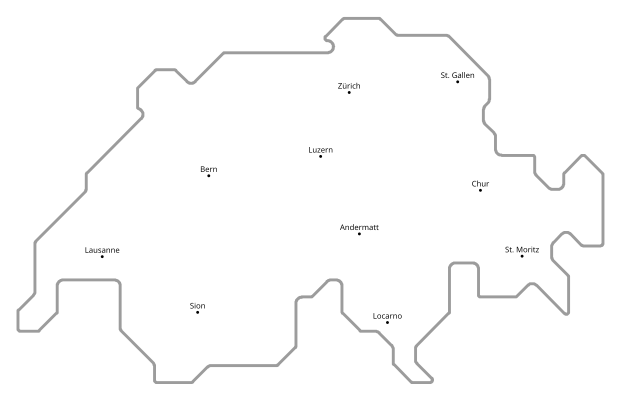FireSwitch: Changes in species communities driven by forest fires as an opportunity to adapt to climate change
Martin Gossner
Marco Moretti
Barbara Moser
Daniel Scherrer
Thomas Wohlgemuth
2023 - 2025
Cooperation FinancingThe projected increase in the frequency of forest fires due to climate change underlines the need for long-term studies on tree regeneration and post-fire succession. These data serve as a basis for adaptive management and intervention plans. Additional vegetation and arthropod surveys will be conducted on two fire areas with different environmental conditions: Leuk (20 years after the fire and 10 years after the last survey) and Visp (12 years after the fire and 5 years after the last survey). The analysis of these long-term successional sequences aims to answer (1) how species composition, distribution of functional traits and interactions between plants and arthropods change during 20 years of forest succession, and (2) which environmental conditions can trigger a permanent change in forest composition after a major disturbance event.
The origin of the project
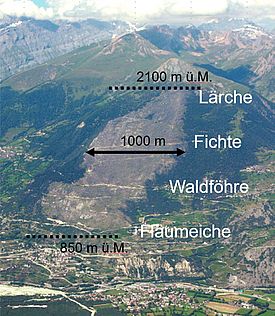
The forest fires of Leuk (2003, burnt area 300 ha, 900-2100 m a.s.l.) and Visp (2011, 130 ha, 700-1600 m a.s.l.) are among the largest fire disasters north of the Swiss Alps since 1900. The socio-economic impact of these forest fires - 4 million Swiss francs in Leuk alone - has not only led to a new forest fire strategy in Valais (Gerold 2019) but also to continuous research on behalf of the canton, especially in the field of regeneration and biodiversity. WSL has monitored vegetation dynamics after fires in Leuk (2004-2007 and 2013) and Visp (2013, 2018) as well as (re)colonisation by arthropods (Leuk; 2005, 2006, 2008 and 2013) and published the results of early forest succession in several scientific and peer-reviewed journals (e.g., Moser, Gimmi & Wohlgemuth 2006; Wohlgemuth et al. 2008a; Moretti et al. 2010; Moser et al. 2010; Wohlgemuth et al. 2010a; Wohlgemuth et al. 2010b; Wohlgemuth et al. 2012; Nussbaumer & Wohlgemuth 2016; Moretti et al. 2018; Wohlgemuth et al. 2018; Wohlgemuth & Moser 2018). The legacy of the Leuk fire helped forest authorities to respond quickly to the next large forest fire in Visp (2011) and furthered our understanding of forest resilience after the fire (Wohlgemuth et al. 2015).
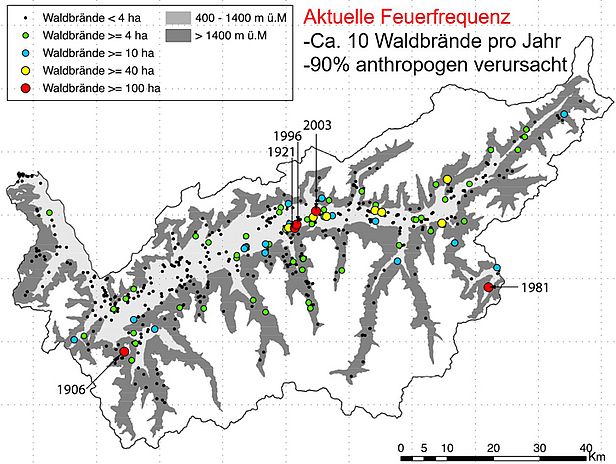
Interestingly, the vegetation records of Leuk and Visp show different courses after disturbance. Preliminary analyses showed that regeneration and early succession after fire seem to proceed much more slowly on the dry, south-exposed slope of Leuk than on the north-exposed, wetter and more nutrient-rich slope in Visp (Wohlgemuth 2015). In Leuk, preliminary results indicate a possible vegetation change (Wilson & Agnew 1992) from a pine forest (before the fire) to an oak-dominated forest at lower elevations (Moser et al. 2010; Nussbaumer & Wohlgemuth 2016). No vegetation changes have yet been observed at the higher elevations in Leuk and on the wetter, more nutrient-rich slope in Visp. The contrasting successional trajectories appear to be caused by the interactions between fire disturbance and climate change and have already been described in the context of drought effects in the Valais (Rigling et al. 2013).
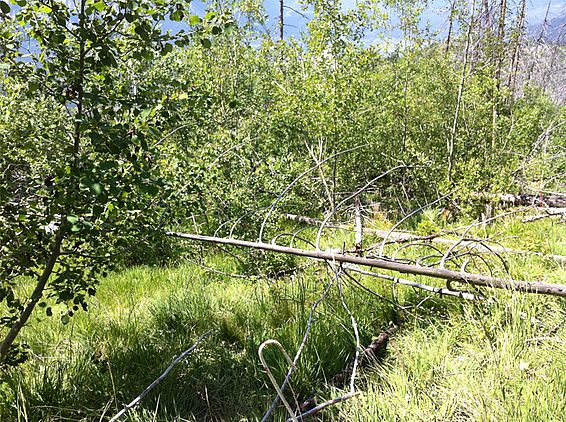
Climate change is altering ecosystems, with models predicting dramatic shifts in species distribution and community composition (e.g. Lenoir et al. 2020; Scherrer et al. 2020), potentially affecting key ecosystem services provided by forests (e.g. Lindner et al. 2014; Jandl et al. 2019). However, recent representative vegetation surveys reported only marginal changes in species composition and range shifts in recent decades (e.g. Lenoir et al. 2008; Bertrand et al. 2011; Scherrer et al. 2017). One possible explanation is related to the successional dynamics that result from large disturbances. Both models (Bugmann et al. 2019; Scherrer et al. 2020) and field studies (Wohlgemuth et al. 2018; Scherrer et al. 2022) show that large disturbances play a key role in paving the way for species shifts by removing asymmetric competition effects (i.e. between established dominant tree species and newly arriving colonisers), thus enabling a faster transition to species assemblages optimally adapted to the 'new' climatic conditions. However, regeneration dynamics after a major disturbance, especially after the fire, depend on more factors than just climate, e.g. species pool, seed dispersal and biotic interactions. Species with a large seed pool, underground organs for resprouting or a high dispersal capacity might have a significant advantage in colonising a recently disturbed area, leading to a changed species composition independent of climate change (e.g. Wohlgemuth et al. 2008b). Similarly, the arthropod community in recently burned areas differed markedly from that of the surrounding forest, reflecting more open conditions and a large number of new resources released through processes of competitive exclusion (Moretti et al. 2010; Moretti et al. 2018). These shifts in arthropod and plant traits largely reflect successional dynamics and show that long-term observations are essential to identify persistent and possibly climate-driven trait shifts. This is also important for ecosystem functions, as different trajectories of successional change in plants and arthropods are likely to alter trophic interactions that are linked to important ecosystem processes.
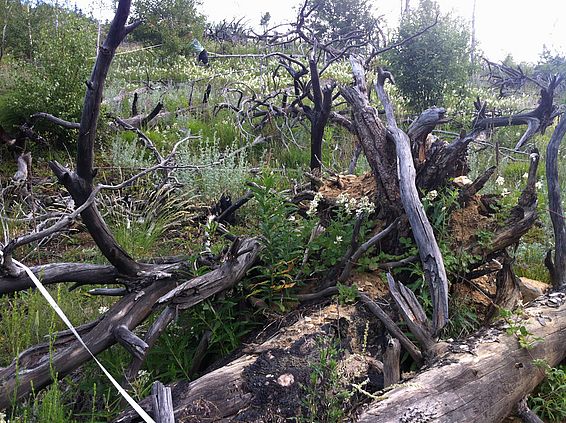
Disentangling successional dynamics and climate-induced adaptations of forests is crucial for developing adaptive management practices for climate-smart forests and predicting impacts on biodiversity. Currently, our understanding of these dynamics is limited by a lack of long-term studies in forests, especially in traditionally less fire-prone regions such as the dry valleys of the Central Alps. With a series of vegetation and arthropod surveys before and after the fires, the forest fires in Leuk and Visp provide a unique opportunity to study "neighbouring" sites with contrasting environmental conditions. The dry slope in Leuk was (before the fire) a forest dominated by Scots pine, but many studies suggest that the predicted increase in summer drought will lead to a shift from Scots pine forests to more drought-resistant oak species, especially at the lowest elevations (Rigling 2006; Gimmi et al. 2010). A recent study by Scherrer et al. (2021) even predicts oak-dominated forests already at lower altitudes in Leuk. In contrast, the wetter and more nutrient-rich slope in Visp is expected to continue to support a spruce forest (i.e. a similar species composition as before the fire). Analysing the long-term successional sequence of these two contrasting sites offers new insights into the role of climate, colonisation history and species traits influencing tree species composition after large fires in traditionally fire-shy ecosystems. Furthermore, the insect and spider data allow us to analyse whether the observed trait shifts in vegetation also lead to a permanent trait shift in arthropod communities and trophic interactions with far-reaching consequences for ecosystem functioning.
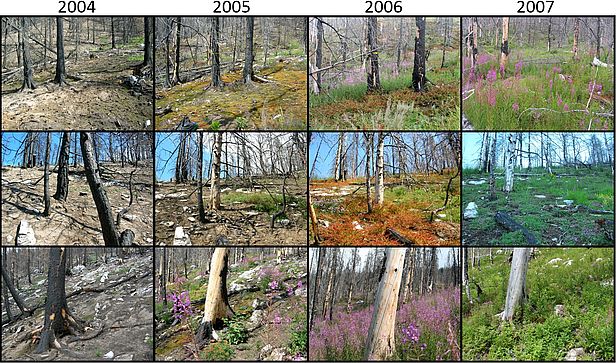
Approach and methods
The project analyses the interaction between fire disturbance and climate warming using unique WSL data sets on forest regeneration and species composition after fires in Leuk and Visp. Five vegetation surveys (2004, 2005, 2006, 2007 and 2013) and four arthropod surveys (2005, 2006, 2008, 2013) were conducted in Leuk, and two additional vegetation surveys were conducted in Visp (2013, 2018). In this project, we will investigate vegetation (especially tree regeneration) and arthropod diversity in Leuk (2023, 20 years after the fire and 10 years after the last survey), complemented by a vegetation survey in Visp (2023, 12 years after the fire and 5 years after the last survey).
We will use these long-term data sets on post-fire forest dynamics to answer the following key questions:
(1) How have overall species diversity, functional trait distribution, and species composition changed (i.e., successional stages) in the decades since the fire?
(2) Is there a relationship between successional dynamics (i.e. trait shifts and species changes) of plants and arthropods? Can an integrated view of plant and arthropod successional dynamics contribute to a better understanding of post-disturbance community assembly and the consequences for trophic interactions and ecosystem functioning?
(3) At what elevations have forest communities either reverted to a state similar to pre-fire conditions in terms of species diversity, distribution of functional traits and species composition, or evolved into new communities?
(4) What environmental factors affect community resilience and community change?
Repeat vegetation surveys will be conducted on the already established systematic sampling grid of 125 m x 125 m within the burned areas. Tree species regeneration will be studied on 50 m2 in Leuk (n = 150) and Visp (n = 45). The species diversity of all vascular plants is recorded on 200 m2 plots in the burned area of Leuk (Wohlgemuth et al. 2010a).
Arthropod diversity is surveyed again at 18 sites along three altitudinal transects (1200, 1450 and 1700 m a.s.l.), divided into three ecosystems: (1) intact forests (control), (2) inner edge of the burnt area and (3) in the centre of the burnt area. Two sets of standard traps targeting flying and ground-dwelling arthropods are set at each site (Obrist & Duelli 2010).

Literature
Bertrand, R., Lenoir, J., Piedallu, C., Riofrio-Dillon, G., de Ruffray, P., Vidal, C., Pierrat, J.C. & Gegout, J.C. (2011) Changes in plant community composition lag behind climate warming in lowland forests. Nature, 479, 517-520.
Bugmann, H., Seidl, R., Hartig, F., Bohn, F., Brůna, J., Cailleret, M., François, L., Heinke, J., Henrot, A.J. & Hickler, T. (2019) Tree mortality submodels drive simulated long‐term forest dynamics: assessing 15 models from the stand to global scale. Ecosphere, 10, e02616.
Gerold, P. (2019) Waldbrandmanagement im Kanton Wallis und Lehren aus dem Brand von Visp im Jahr 2011. Schweizerische Zeitschrift für Forstwesen, 170, 251-257.
Gimmi, U., Wohlgemuth, T., Rigling, A., Hoffmann, C.W. & Bürgi, M. (2010) Land-use and climate change effects in forest compositional trajectories in a dry Central-Alpine valley. Annals of forest science, 67, 701.
Jandl, R., Spathelf, P., Bolte, A. & Prescott, C.E. (2019) Forest adaptation to climate change—is non-management an option? Annals of forest science, 76, 48.
Lenoir, J., Bertrand, R., Comte, L., Bourgeaud, L., Hattab, T., Murienne, J. & Grenouillet, G. (2020) Species better track climate warming in the oceans than on land. Nature ecology & evolution, 4, 1044-1059.
Lenoir, J., Gegout, J.C., Marquet, P.A., de Ruffray, P. & Brisse, H. (2008) A significant upward shift in plant species optimum elevation during the 20th century. Science, 320, 1768-1771.
Lindner, M., Fitzgerald, J.B., Zimmermann, N.E., Reyer, C., Delzon, S., van der Maaten, E., Schelhaas, M.J., Lasch, P., Eggers, J., van der Maaten-Theunissen, M., Suckow, F., Psomas, A., Poulter, B. & Hanewinkel, M. (2014) Climate change and European forests: what do we know, what are the uncertainties, and what are the implications for forest management? Journal of Environmental Management, 146, 69-83.
Moretti, M., De Cáceres, M., Pradella, C., Obrist, M.K., Wermelinger, B., Legendre, P. & Duelli, P. (2010) Fire‐induced taxonomic and functional changes in saproxylic beetle communities in fire sensitive regions. Ecography, 33, 760-771.
Moretti, M., Wermelinger, B., Gossner, M.M. & Obrist, M.K. (2018) Wiederbesiedlung der Waldbrandfläche von Leuk durch Gliederfüsser. Schweizerische Zeitschrift für Forstwesen, 169, 290-298.
Moser, B., Gimmi, U. & Wohlgemuth, T. (2006) Ausbreitung des Erdbeerspinats Blitum virgatum nach dem Waldbrand von Leuk, Wallis (2003). Botanica Helvetica, 116, 179-207.
Moser, B., Temperli, C., Schneiter, G. & Wohlgemuth, T. (2010) Potential shift in tree species composition after interaction of fire and drought in the Central Alps. European Journal of Forest Research, 129, 625-633.
Nussbaumer, C. & Wohlgemuth, T. (2016) Verbiss bremst die jungen Flaumeichen. Wald und Holz, 97, 31-33.
Obrist, M. & Duelli, P. (2010) Rapid biodiversity assessment of arthropods for monitoring average local species richness and related ecosystem services. Biodiversity and Conservation, 19, 2201-2220.
Rigling, A. (2006) Verdrängen Flaumeichen die Walliser Waldföhren? Merkblatt für die Praxis. pp. 1-16. Eidg. Forschungsanstalt für Wald, Schnee und Landschaft WSL, Birmensdorf.
Rigling, A., Bigler, C., Eilmann, B., Feldmeyer‐Christe, E., Gimmi, U., Ginzler, C., Graf, U., Mayer, P., Vacchiano, G. & Weber, P. (2013) Driving factors of a vegetation shift from Scots pine to pubescent oak in dry Alpine forests. Global Change Biology, 19, 229-240.
Scherrer, D., Ascoli, D., Conedera, M., Fischer, C., Maringer, J., Moser, B., Nikolova, P.S., Rigling, A. & Wohlgemuth, T. (2022) Canopy Disturbances Catalyse Tree Species Shifts in Swiss Forests. Ecosystems, 25, 199-214.
Scherrer, D., Baltensweiler, A., Fischer, C., Frehner, M., Wüest Karpati, R. & Wohlgemuth, T. (2021) Räumlich explizite Modellierung der NaiS-Standorttypen zur Analyse der Waldbestockung. Schweizerische Zeitschrift für Forstwesen, 172, 278-285.
Scherrer, D., Massy, S., Meier, S., Vittoz, P. & Guisan, A. (2017) Assessing and predicting shifts in mountain forest composition across 25 years of climate change. Diversity and Distributions, 23, 517-528.
Scherrer, D., Vitasse, Y., Guisan, A., Wohlgemuth, T. & Lischke, H. (2020) Competition and demography rather than dispersal limitation slow down upward shifts of trees’ upper elevation limits in the Alps. Journal of Ecology, 108, 2416-2430.
Wilson, J.B. & Agnew, A.D. (1992) Positive-feedback switches in plant communities. Advances in Ecological Research, pp. 263-336. Elsevier.
Wohlgemuth, T. (2015) Baumverjüngung in der Waldbrandfläche Visp (2011). Kurzer Bericht an den Kanton Wallis. pp. 6. Eidg. Forschungsanstalt für Wald, Schnee und Landschaft WSL, Birmensdorf.
Wohlgemuth, T., Brigger, A., Gerold, P., Laranjeiro, L., Moretti, M., Moser, B., Rebetez, M., Schmatz, D., Schneiter, G. & Sciacca, S. (2012) Leben mit Waldbrand am Beispiel von Leuk (VS) 2003. Vierteljahrsschrift der Naturforschenden Gesellschaft in Zürich, 157, 97-106.
Wohlgemuth, T., Brigger, A., Gerold, P., Laranjeiro, L., Moretti, M., Moser, B., Rebetez, M., Schmatz, D., Schneiter, G., Sciacca, S., Sierro, A., Weibel, P., Zumbrunnen, T. & Conedera, M. (2010a) Leben mit Waldbrand. Eidg. Forschungsanstalt für Wald, Schnee und Landschaft WSL, Birmensdorf.
Wohlgemuth, T., Conedera, M., Albisetti, A.K., Moser, B., Usbeck, T., Brang, P. & Dobbertin, M. (2008a) Effekte des Klimawandels auf Windwurf, Waldbrand und Walddynamik im Schweizer Wald| Effects of climate change on windthrow, forest fire and forest dynamics in Swiss forests. Schweizerische Zeitschrift für Forstwesen, 159, 336-343.
Wohlgemuth, T., Conedera, M., Engesser, R., Wermelinger, B., Reinhard, M., Forster, B. & Meier, F. (2015) Waldschäden. Zustand und Nutzung des Schweizer Waldes (eds A. Rigling & H.P. Schaffer). BAFU, Bern, Switzerland.
Wohlgemuth, T., Conedera, M., Kupferschmid, A., Moser, B., Usbeck, T., Brang, P. & Dobbertin, M. (2008b) Effekte des Klimawandels auf Windwurf, Waldbrand und Walddynamik im Schweizer Wald. Schweizerische Zeitschrift für Forstwesen, 159, 336-343.
Wohlgemuth, T., Doublet, V., Nussbaumer, C., Feichtinger, L. & Rigling, A. (2018) Baumartenwechsel in den Walliser Waldföhrenwäldern verstärkt nach grossen Störungen. Schweizerische Zeitschrift für Forstwesen, 169, 260-268.
Wohlgemuth, T., Hester, C., Jost, A.-R., Wasem, U. & Moser, B. (2010b) Dynamik der Wiederbewaldung im Waldbrandgebiet von Leuk (Wallis)| Recruitment dynamics following the forest fire near Leuk (Valais). Schweizerische Zeitschrift für Forstwesen, 161, 450-459.
Wohlgemuth, T. & Moser, B. (2018) Zehn Jahre Vegetationsdynamik auf der Waldbrandfläche von Leuk (Wallis). Schweizerische Zeitschrift für Forstwesen, 169, 279-289.
